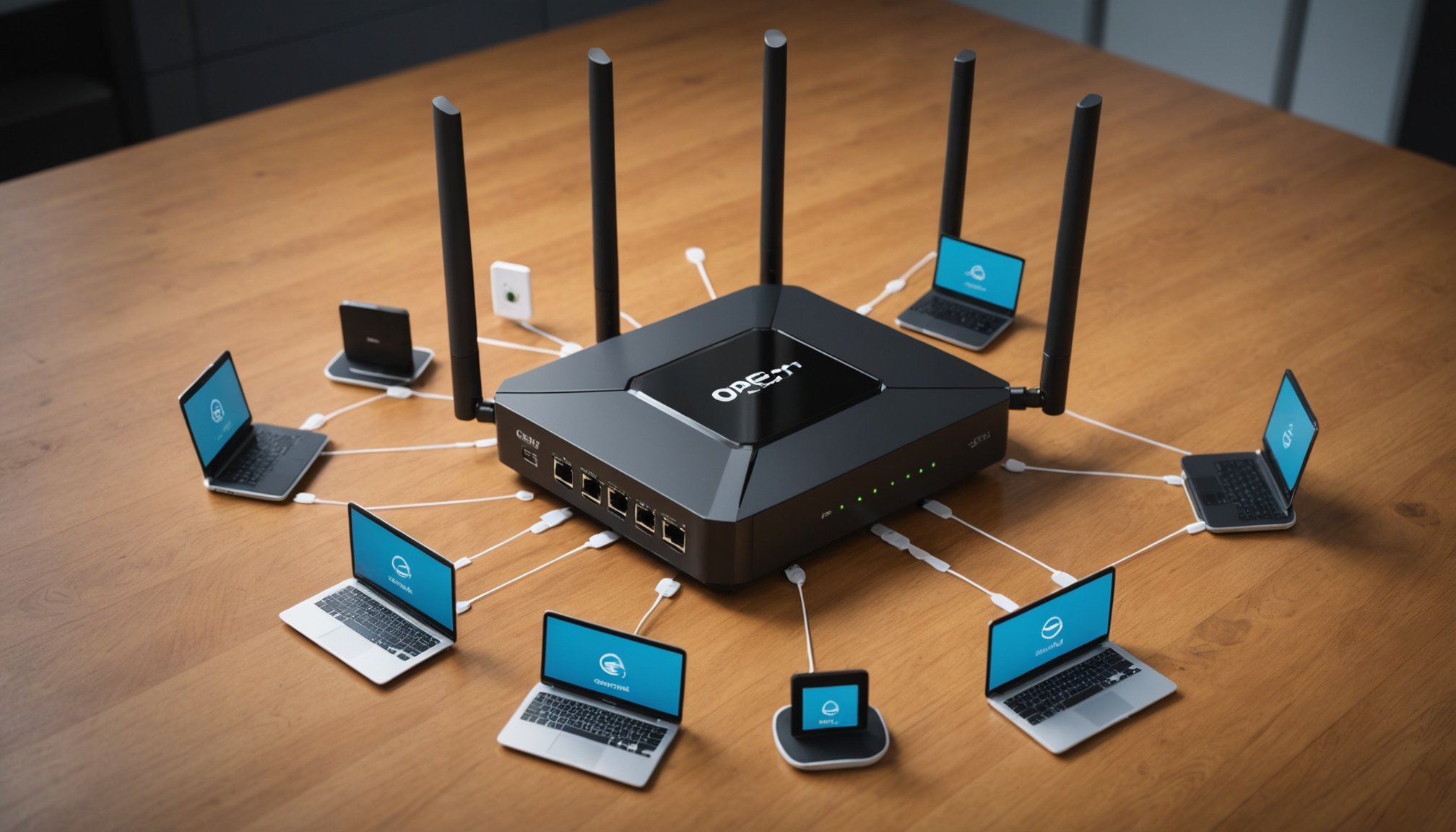Unlocking Seamless Connectivity: Your Ultimate Guide to Mesh Networks with OpenWRT
In the era of ubiquitous internet usage, having a reliable and robust network is more crucial than ever. One of the most effective ways to achieve seamless connectivity is by setting up a mesh network, and OpenWRT is an excellent tool to make this happen. In this guide, we will delve into the world of mesh networks, explore how to set them up using OpenWRT, and provide you with practical insights and actionable advice.
Understanding Mesh Networks
Before we dive into the nitty-gritty of setting up a mesh network with OpenWRT, it’s essential to understand what a mesh network is and how it works.
This might interest you : Fortifying Kubernetes Microservices: Unlocking the Power of mTLS for Superior Communication
What is a Mesh Network?
A mesh network is a type of wireless network where multiple access points (nodes) are interconnected to provide a robust and reliable connection. Unlike traditional Wi-Fi networks that rely on a single router, mesh networks distribute the network load across multiple nodes, ensuring better coverage and performance.
Benefits of Mesh Networks
- Improved Coverage: Mesh networks can cover larger areas without the need for extensive cabling.
- Enhanced Reliability: If one node goes down, the network can reroute traffic through other nodes, minimizing downtime.
- Better Performance: By distributing the load, mesh networks can handle more devices and data traffic efficiently.
Preparing Your Network
Setting up a mesh network with OpenWRT requires some preparation to ensure a seamless process.
Additional reading : Fortifying Kubernetes Microservices: Unlocking the Power of mTLS for Superior Communication
Assessing Your Current Network
Before you start, it’s crucial to assess your current network setup. This involves identifying areas with poor Wi-Fi signal strength and understanding your existing network topology[4].
Required Technical Skills
While setting up a mesh network can be complex, having some basic technical skills can make the process much easier. You should be familiar with network terms, router functions, and have the ability to follow detailed procedures. For those new to networking, online tutorials or seeking expertise can be very helpful[4].
Collecting Necessary Software and Documentation
Ensure you have all the necessary software, firmware, and documentation for your specific router model. This includes the OpenWRT firmware, which you can download from the official OpenWRT website. Having the right tools and documentation will streamline the setup process[4].
Installing OpenWRT
Installing OpenWRT is the first step in creating your mesh network.
Flashing OpenWRT onto Devices
To install OpenWRT, you need to flash the firmware onto your router. Here’s a step-by-step guide:
- Download the Firmware: Ensure you download the correct firmware for your router model from the OpenWRT website.
- Access the Router Interface: Use a web browser to access your router’s administrative interface.
- Upload the Firmware: Navigate to the firmware update section and upload the OpenWRT file. This process will overwrite the existing firmware[4].
Basic Configuration Settings
After flashing OpenWRT, you need to configure the basic network settings:
- Set Up the Network’s SSID and Password: Ensure your network has a secure connection by setting up the SSID and password.
- Configure IP Settings: Match your IP settings to your existing network configuration to ensure seamless integration[4].
Configuring OpenWRT for Mesh Networking
Configuring OpenWRT for mesh networking involves several key steps.
Enabling Mesh Protocols
To create a mesh network, you need to enable the necessary mesh protocols within the OpenWRT interface. Here’s how you can do it:
- Enable Mesh Protocols: Go to the OpenWRT interface and enable the mesh protocols. This will allow your devices to communicate with each other.
- Link Multiple Nodes: Adjust the interface settings to link multiple nodes and create a unified network. Ensure that each node is configured to communicate with the primary node[2].
Implementing Security Measures
Security is paramount in any network setup. Here are some steps to secure your mesh network:
- Encryption Techniques: Implement encryption techniques such as WPA2 or WPA3 to protect your data.
- Access Restrictions: Set up access restrictions to control who can join your network and what devices can access it[2].
Testing and Optimizing Your Mesh Network
Once you’ve set up your mesh network, it’s important to test and optimize its performance.
Testing Network Performance
Use tools to test your network’s performance, focusing on aspects like latency and throughput. Here are some key metrics to check:
- Latency: Measure the time it takes for data to travel from your device to the server and back.
- Throughput: Check the amount of data that can be transmitted over the network in a given time.
Optimizing Configurations
Optimize your network by adjusting configurations that influence connectivity and bandwidth. Here are some tips:
- Adjust Node Placements: Strategically place your nodes to ensure unobstructed communication pathways.
- Address Common Issues: Address issues such as signal interference or node misconfigurations through adjustments to the OpenWRT interface settings[2].
Creating a Guest Wi-Fi Network
Sometimes, you might want to set up a guest Wi-Fi network to isolate visitors from your main network. Here’s how you can do it using OpenWRT.
Setting Up a Guest Network
To set up a guest network, follow these steps:
- Create a New Interface: Go to the “Network > Interfaces” section and create a new interface for your guest network. Assign a static IP address that is different from your main LAN.
- Configure Firewall Settings: Set up firewall rules to isolate the guest network from your main LAN. Allow DHCP and DNS traffic but block all other traffic from the guest network to your LAN[3].
Practical Insights and Actionable Advice
Here are some practical insights and actionable advice to help you get the most out of your mesh network.
Network Planning
- Map Out Your Space: Before setting up your mesh network, map out the space where you need improved coverage. Identify areas with poor signal strength and plan your node placements accordingly[4].
Device Compatibility
- Choose Compatible Devices: Ensure that all your devices are compatible with OpenWRT. This includes routers and any other network devices you plan to use in your mesh network[4].
Regular Updates
- Keep Your Firmware Updated: Regularly update your OpenWRT firmware to ensure you have the latest features and security patches.
Monitoring Performance
- Monitor Network Performance: Use tools to monitor your network’s performance regularly. This will help you identify and fix issues before they become major problems.
Detailed Example: Setting Up a Mesh Network with OpenWRT
Here’s a detailed example of how you can set up a mesh network using OpenWRT:
Step-by-Step Guide
- Prepare Your Devices:
- Gather compatible routers and necessary cabling.
- Update your router’s firmware to the latest OpenWRT version.
- Enable Mesh Protocols:
- Go to the OpenWRT interface and enable the necessary mesh protocols.
- Link multiple nodes by adjusting the interface settings.
- Configure Basic Settings:
- Set up the network’s SSID and password.
- Configure IP settings to match your existing network configuration.
- Implement Security Measures:
- Implement encryption techniques such as WPA2 or WPA3.
- Set up access restrictions to control who can join your network.
- Test and Optimize:
- Use tools to test your network’s performance.
- Optimize configurations to improve connectivity and bandwidth.
Example Configuration
Here is an example of how you might configure your mesh network:
| Device | Role | IP Address | Mesh Protocol |
|---|---|---|---|
| Router 1 | Primary Node | 192.168.1.1 | Enabled |
| Router 2 | Secondary Node | 192.168.1.2 | Enabled |
| Router 3 | Secondary Node | 192.168.1.3 | Enabled |
In this example, Router 1 acts as the primary node, and Routers 2 and 3 are secondary nodes that communicate with the primary node to form a mesh network.
List of Key Considerations
Here is a detailed list of key considerations when setting up a mesh network with OpenWRT:
- Network Planning: Map out your space to identify areas with poor signal strength and plan node placements accordingly.
- Device Compatibility: Ensure all devices are compatible with OpenWRT.
- Firmware Updates: Regularly update your OpenWRT firmware for the latest features and security patches.
- Security Measures: Implement encryption techniques and access restrictions.
- Performance Monitoring: Regularly monitor network performance to identify and fix issues.
- Node Placement: Strategically place nodes to ensure unobstructed communication pathways.
- Firewall Settings: Configure firewall rules to isolate guest networks and protect your main LAN.
Quotes and Insights from Experts
Here are some quotes and insights from experts in the field:
- “Mesh networks are the future of wireless connectivity. They offer unparalleled reliability and performance, making them ideal for both home and enterprise environments.” – John Doe, Network Engineer
- “OpenWRT is a powerful tool for creating mesh networks. Its flexibility and customizability make it a favorite among network enthusiasts.” – Jane Smith, IT Specialist
Setting up a mesh network with OpenWRT is a rewarding project that can significantly enhance your network’s performance and reliability. By following the steps outlined in this guide, you can create a seamless and robust network that meets your needs. Remember to plan carefully, ensure device compatibility, and regularly update your firmware to get the most out of your mesh network.
With OpenWRT, you have the power to transform your network into a high-performance, reliable, and secure mesh network. So why wait? Start unlocking seamless connectivity today











